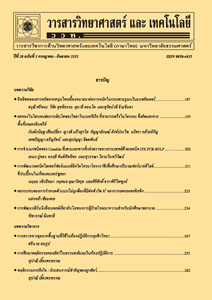การตรวจวัดสมบัติเชิงพลศาสตร์ของพระเจดีย์วัดใหญ่ชัยมงคล จังหวัดพระนครศรีอยุธยา
Main Article Content
Abstract
บทคัดย่อ
จังหวัดพระนครศรีอยุธยามีโบราณสถานที่ทรงคุณค่าต่อประเทศอยู่เป็นจำนวนมาก และได้รับการยกย่องเป็นมรดกโลกโดยองค์กร UNESCO ปัจจุบันโครงสร้างเหล่านี้ได้เกิดการเสื่อมสภาพไปตามกาลเวลาและผลกระทบต่าง ๆ จากสภาพแวดล้อม เช่น สภาพอากาศ การทรุดตัวของดิน หรืออุทกภัย และส่งผลเสียต่อความมั่นคงแข็งแรงของโครงสร้าง ดังนั้นจึงควรมีการดำเนินการศึกษาวิจัยสำหรับการวางแผนเพื่อการอนุรักษ์โครงสร้างเหล่านี้อย่างมีประสิทธิภาพ งานวิจัยนี้ได้ศึกษาสมบัติเชิงพลศาสตร์ของพระเจดีย์วัดใหญ่ชัยมงคล จังหวัดพระนครศรีอยุธยา ซึ่งเป็นเจดีย์รูปทรงระฆังคว่ำ มีความสูงประมาณ 70 เมตร และสร้างขึ้นในราว พ.ศ. 2135 เจดีย์องค์นี้มีการเสื่อมสภาพตามกาลเวลาที่สามารถตรวจพบจากเนื้อของวัสดุและเกิดการเอียงตัวที่มองเห็นอย่างชัดเจน การศึกษานี้ดำเนินการตรวจวัดสมบัติเชิงพลศาสตร์ของพระเจดีย์จากการสั่นไหวในสภาพแวดล้อม เพื่อหาค่าความถี่ธรรมชาติของการสั่นทางด้านข้างโดยใช้การแปลงสัญญาณฟูเรียร์ และหารูปร่างการสั่นไหวจากอัตราส่วนของขนาดฟูเรียร์ โดยผลการศึกษาที่ได้จะสามารถนำไปใช้ในการปรับแก้แบบจำลองแบบไฟไนต์เอลิเมนต์เพื่อใช้วิเคราะห์พฤติกรรมการรับน้ำหนักของเจดีย์และเป็นค่าอ้างอิงเพื่อการตรวจสอบการเปลี่ยนแปลงสมบัติของพระเจดีย์ในอนาคต
คำสำคัญ : สมบัติเชิงพลศาสตร์; การทดสอบการสั่นไหวจากสภาพแวดล้อม; เจดีย์โบราณสถาน; อยุธยา
Abstract
Ayutthaya, Thailand, has many valuable historical remains and has been considered as a UNESCO World Heritage Site. The present archaeological structures have been suffered from several causes of deterioration, such as weather, ground settlement, flood, and other environmental factors. These causes directly affect the stability of the ruins and therefore conservation plans should be conducted through essential studies. This research investigates dynamic properties of a bell-shape masonry stupa, which is the main stupa of Wat Yai Chaimongkol, Ayutthaya, Thailand. The 70-meter high stupa constructed in A.D. 1592 has been subjected to aging and adverse environment effects. At present, inclination of the stupa and deterioration of material are clearly observable. In this study, dynamic characteristics of the stupa were identified by ambient vibration measurements. Natural frequencies of the translational modes were obtained from Fourier spectrum of the measured vibrations of the stupa. Vibration mode shapes were computed from the ratio of the Fourier amplitudes. The results of the dynamics properties can be used to calibrate the Finite Element model for further structural assessments and serve as reference values for long-term monitoring.
Keywords: dynamic properties; ambient vibration test; ancient stupa; Ayutthaya


